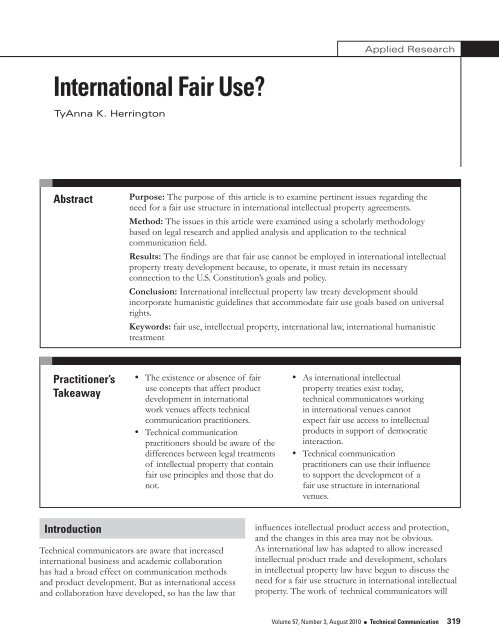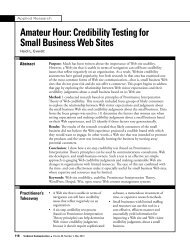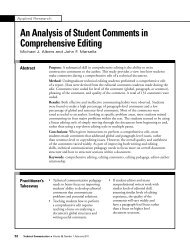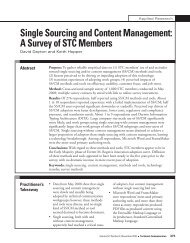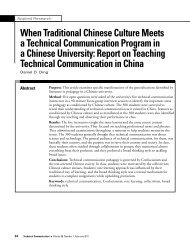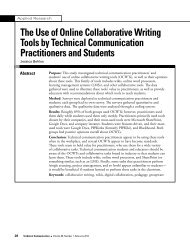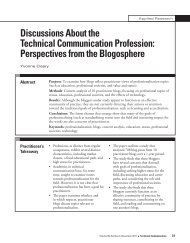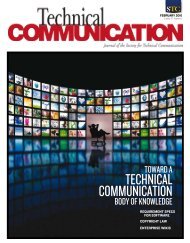Applied ResearchConsuming Digital RightsPotts, L. (2009a). Designing for disaster: Social softwareuse in times of crisis. International Journal ofSociotechnology and Knowledge Development, 1(2), 33–46.Potts, L. (2009b). Using actor network theory to traceand improve multimodal communication design.Technical Communication Quarterly, 18, 281–301.Ron in Richmond. (2009, July 16). Comment [Onlineforum comment]. Retrieved from: http://www.amazon.com/tag/kindle/forum/ref=cm_cd_search_res_ti?_encoding=UTF8&cdMsgNo=12&cdPage=1&cdSort=oldest&cdThread=Tx1QUP1NLUY4Q5M&cdMsgID=MxN5IRNPP1Z56O#MxN5IRNPP1Z56OSamuelson, P. (2003). DRM {and, or, vs.] the law.Communications of the ACM, 46(4), 41–45.Spinuzzi, C. (2008). Network: Theorizing knowledge workin telecommunications. New York, NY: CambridgeUniversity Press.St.Amant, K. (2002). When cultures and computerscollide: Rethinking computer-mediatedcommunication according to international andintercultural communication expectations. Journal ofBusiness and Technical Communication, 16, 196–214.St.Amant, K. (2005). A prototype theory approachto website localization: An analytical method fortechnical communicators.” Proceedings of the IEEEInternational Professional Communication Conference (pp.101–107).Sunny Lady. (2009, July 16). Comment [Online forumcomment]. Retrieved from: http://www.amazon.com/tag/kindle/forum/ref=cm_cd_search_res_ti?_encoding=UTF8&cdMsgNo=17&cdPage=1&cdSort=oldest&cdThread=Tx1QUP1NLUY4Q5M&cdMsgID=Mx15LBWMOL9BIPV#Mx15LBWMOL9BIPVSwarts, J. (2009). The collaborative construction of“fact” on Wikipedia. Proceedings of the 27 th ACMinternational conference on Design of Communication.Bloomington, IN: SIGDOC.Thatcher, B. (2001). Issues of validity in interculturalprofessional communication research. Journal ofBusiness and Technical Communication, 15, 458–489.Vaidhyanathan, S. (2005). The anarchist in the library: Howthe clash between freedom and control is hacking the realworld and crashing the system. New York, NY: BasicBooks.Voss, D. & Flammia, M. (2007). Ethical and interculturalchallenges for technical communicators andmanagers in a shrinking global marketplace. TechnicalCommunication, 54, 72–97.Wang, Y., & Wang, D. (2009). Cultural contexts intechnical communication: A study of Chineseand German automobile literature. TechnicalCommunication, 56, 39–50.Wetcoast. (2009). Comment [Online forumcomment]. Retrieved from: http://boingboing.net/2009/07/17/amazon-zaps-purchase.html#comment-544653Zahedi, F., Van Pelt, W. V., & Song, J. (2001). Aconceptual framework for international Web design.IEEE Transactions on Professional Communication, 44,83–103.About the AuthorLiza Potts is an assistant professor of writing, culture,and technology and the co-director of the CeME Lab atOld Dominion University. Her research interests includetechnologically mediated communication, experience design, andparticipatory culture. She has been active in the software andInternet industries since 1994, including positions as a director ofdesign research, social experience strategist, information architect,user interface program manager, and technical communicator.She is the treasurer/secretary of the Association for ComputingMachinery’s SIGDOC. Contact: lkpotts@gmail.comManuscript received 15 October 2009; revised 23 February 2010;accepted 19 March 2010.318 Technical Communication l Volume 57, Number 3, August 2010
Applied ResearchInternational Fair Use?TyAnna K. HerringtonAbstractPurpose: The purpose of this article is to examine pertinent issues regarding theneed for a fair use structure in international intellectual property agreements.Method: The issues in this article were examined using a scholarly methodologybased on legal research and applied analysis and application to the technicalcommunication field.Results: The findings are that fair use cannot be employed in international intellectualproperty treaty development because, to operate, it must retain its necessaryconnection to the U.S. Constitution’s goals and policy.Conclusion: International intellectual property law treaty development shouldincorporate humanistic guidelines that accommodate fair use goals based on universalrights.Keywords: fair use, intellectual property, international law, international humanistictreatmentPractitioner’sTakeaway• The existence or absence of fairuse concepts that affect productdevelopment in internationalwork venues affects technicalcommunication practitioners.• Technical communicationpractitioners should be aware of thedifferences between legal treatmentsof intellectual property that containfair use principles and those that donot.• As international intellectualproperty treaties exist today,technical communicators workingin international venues cannotexpect fair use access to intellectualproducts in support of democraticinteraction.• Technical communicationpractitioners can use their influenceto support the development of afair use structure in internationalvenues.IntroductionTechnical communicators are aware that increasedinternational business and academic collaborationhas had a broad effect on communication methodsand product development. But as international accessand collaboration have developed, so has the law thatinfluences intellectual product access and protection,and the changes in this area may not be obvious.As international law has adapted to allow increasedintellectual product trade and development, scholarsin intellectual property law have begun to discuss theneed for a fair use structure in international intellectualproperty. The work of technical communicators willVolume 57, Number 3, August 2010 l Technical Communication 319
- Page 1 and 2:
AUGUST 2010Volume 57 Number 3SPECIA
- Page 3 and 4:
PresidentMichael A. HughesVice Pres
- Page 5 and 6:
VoLuME 57, NuMBER 3AUGUST 2010ISSN
- Page 7 and 8:
Guest EditorialKirk St.Amant and Ma
- Page 9 and 10:
Applied ResearchTechnical Communica
- Page 11 and 12:
Applied ResearchNicole St. Germaine
- Page 13 and 14:
Applied ResearchNicole St. Germaine
- Page 15 and 16:
Applied ResearchNicole St. Germaine
- Page 17 and 18:
Applied ResearchNicole St. Germaine
- Page 19 and 20:
Applied ResearchNicole St. Germaine
- Page 21 and 22:
Applied ResearchNicole St. Germaine
- Page 23 and 24:
Applied ResearchNicole St. Germaine
- Page 25 and 26: Applied TheoryTatiana BatovaIntrodu
- Page 27 and 28: Applied TheoryTatiana BatovaMoreno,
- Page 29 and 30: Applied TheoryTatiana BatovaThe Uni
- Page 31 and 32: Applied TheoryTatiana Batovadoctors
- Page 33 and 34: Applied TheoryTatiana BatovaTo addr
- Page 35 and 36: Applied TheoryTatiana Batovathe loc
- Page 37 and 38: Applied TheoryTatiana BatovaJohnson
- Page 39 and 40: Applied TheoryTatiana BatovaInterna
- Page 41 and 42: Applied TheoryMcKee and PorterIntro
- Page 43 and 44: Applied TheoryMcKee and PorterFor e
- Page 45 and 46: Applied TheoryMcKee and Porterpubli
- Page 47 and 48: Applied TheoryMcKee and PorterBecau
- Page 49 and 50: Applied TheoryMcKee and Porterof th
- Page 51 and 52: Applied TheoryMcKee and Porterwith
- Page 53 and 54: Applied TheoryMcKee and PorterA Cop
- Page 55 and 56: Applied TheoryMcKee and PorterConte
- Page 57 and 58: Applied TheoryMcKee and PorterWalto
- Page 59 and 60: Applied ResearchLiza PottsIntroduct
- Page 61 and 62: Applied ResearchLiza Pottsdoes not
- Page 63 and 64: Applied ResearchLiza PottsUser’s
- Page 65 and 66: Applied ResearchLiza Pottsactors, t
- Page 67 and 68: Applied ResearchLiza PottsDRM has a
- Page 69 and 70: Applied ResearchLiza Pottsmake bett
- Page 71 and 72: Applied ResearchLiza PottsOne viewe
- Page 73 and 74: Applied ResearchLiza Pottsinvolved
- Page 75: Applied ResearchLiza PottsHayhoe, G
- Page 79 and 80: Applied ResearchTyAnna K. Herringto
- Page 81 and 82: Applied ResearchTyAnna K. Herringto
- Page 83 and 84: Applied ResearchTyAnna K. Herringto
- Page 85 and 86: Applied ResearchTyAnna K. Herringto
- Page 87 and 88: Applied ResearchTyAnna K. Herringto
- Page 89 and 90: Book ReviewsWriting Successful Scie
- Page 91 and 92: Book ReviewsThe Process: Business P
- Page 93 and 94: Book ReviewsHCI Beyond the GUI: Des
- Page 95 and 96: Book ReviewsOrigins of the Specious
- Page 97 and 98: Book Reviewsgenre, and process, top
- Page 99 and 100: Book ReviewsPart One goes from the
- Page 101 and 102: Book Reviewsrather than writers, an
- Page 103 and 104: Book ReviewsHow to Write Fast Under
- Page 105 and 106: Book Reviewsmanagement system (CMS)
- Page 107 and 108: Book Reviewsnearly strangled when h
- Page 109 and 110: Book Reviewsinteractive TV model)
- Page 111 and 112: Book ReviewsOtherwise, Beech shows
- Page 113 and 114: Book Reviewssuch as blog, I found m
- Page 115 and 116: Book Reviewsemployees and effective
- Page 117 and 118: Recent & RelevantSherry Southard, E
- Page 119 and 120: Recent & RelevantRecent & RelevantC
- Page 121 and 122: Recent & RelevantRecent & RelevantE
- Page 123 and 124: Recent & Relevantworking in a langu
- Page 125 and 126: Recent & RelevantWhat’s the big d
- Page 127 and 128:
Recent & RelevantScientific Writing
- Page 129 and 130:
Recent & Relevantapplicability. Man
- Page 131:
Did You Missthe Summit?Don’t miss


